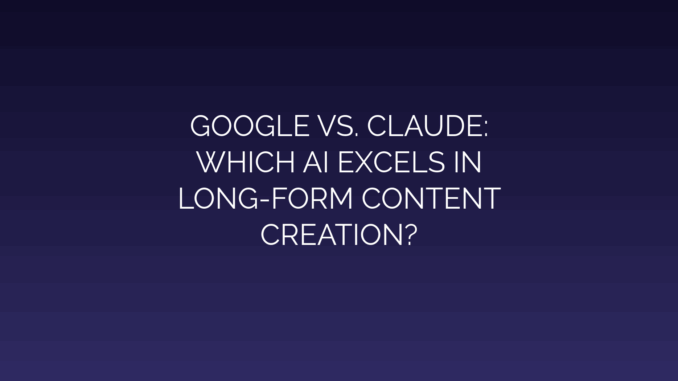
Google vs. Claude: Which AI Excels in Long-Form Content Creation?
The demand for comprehensive, wellstructured longform content—such as whitepapers, reports, ebooks, and indepth articles—continues to surge across industries. As businesses and creators seek scalable solutions, generative AI tools like Google’s Gemini and Anthropic’s Claude have emerged as frontrunners. This comparative analysis examines which platform excels in creating extended content, evaluating key factors like coherence, creativity, accuracy, and workflow efficiency.
The Growing Importance of Long-Form AI Content
Longform content (typically 1,500+ words) establishes authority, boosts SEO, and engages audiences with substantive value. Unlike short snippets, it demands:
- Sustained contextual understanding to maintain theme consistency.
- Structural sophistication for logical flow across sections.
- Minimal hallucinations to ensure factual integrity.
- Adaptability to nuanced tones (e.g., academic vs. conversational).
Both Google and Claude claim strengths here, but their architectures yield distinct results.
Google Gemini: The Search Giant’s Contender
Built on Google’s LaMDA and PaLM 2 lineage, Gemini leverages the company’s vast data reservoirs and realtime search capabilities. Key features for longform creation include:
Strengths
- Real-Time Research Integration: Gemini dynamically pulls current data from Google Search, supporting fact-heavy content like market reports.
- Multimodal Inputs: Processes images, charts, and URLs to enrich drafts (e.g., generating analysis from a dataset).
- Google Ecosystem Synergy: Direct export to Docs, integration with Workspace, and support for markdown formatting.
- Scalability: Efficiently handles bulk operations, like generating multiple section drafts.
Weaknesses
- Inconsistent Depth: May prioritize breadth over depth in complex topics.
- Source Attribution Gaps: Rarely cites references clearly, risking plagiarism concerns.
- Repetition Risks: Struggles with redundancy in ultra-long contexts (>5,000 words).
Ideal for: Datadriven projects requiring uptodate statistics and seamless Google Workspace integration.
Claude 3: Anthropic’s Long-Context Specialist
Claude 3 (Opus/Sonnet models) emphasizes “constitutional AI,” aligning outputs with userdefined principles. Its standout feature is a 200K token context window (~150,000 words), enabling unprecedented document retention.
Strengths
- Contextual Mastery: Remembers user instructions, style guides, and source material across 100+ pages.
- Structural Precision: Outlines subtopics autonomously and adjusts pacing.
- Ethical Safeguards: Refuses harmful requests and cites sources proactively.
- Tonal Flexibility: Adapts seamlessly between technical, creative, and formal voices.
Weaknesses
- No Real-Time Web Access: Relies on pre-trained data (updated ~2023), limiting current-events coverage.
- Slower Output Generation: Delays in processing maximal-context requests.
- Limited Multimodality: Cannot interpret images/charts in all plans.
Ideal for: Book chapters, technical manuals, or compliance documentation needing rigorous consistency.
Key Metrics Compared
| Criteria | Google Gemini | Claude 3 | |||| | Max Context Length | 1M tokens (limited preview) | 200K tokens | | Factual Accuracy | High (with realtime search) | High (lower for post2023 events) | | Output Originality | Moderate | High | | Source Attribution | Weak | Strong | | Tonal Adaptation | Moderate | Exceptional | | Formatting Support | Markdown, HTML | Markdown, LaTeX |
Case Study: Writing a 4,000-Word Technical Guide
Task: Create a guide detailing “ZeroTrust Cybersecurity Frameworks.”
Gemini Workflow: 1. Pulls 2024 threat statistics via Google Search. 2. Generates broad sections quickly. 3. Struggles with advanced nuances (e.g., cryptographic protocols) without multiple prompts. 4. Output requires manual restructuring to enhance depth.
Claude Workflow: 1. Analyzes uploaded whitepapers to inform terminology and structure. 2. Builds layered arguments connecting authentication, encryption, and compliance. 3. Maintains glossary consistency across 10+ sections. 4. Cites NIST standards accurately.
Verdict: Claude delivers greater technical coherence, while Gemini excels in integrating latest trends.
Scalability and Enterprise Use Cases
- Gemini Scales Simpler Projects: Efficient for templatized content (e.g., product catalogs), APIs for bulk generation, and cost-effective tiers.
- Claude Dominates Complex Work: Patent drafts, academic papers, or legal contracts demanding unified narratives and minimal hallucination risks. Multishot prompting allows iterative refining.
The Cost Factor
- Gemini: Free tier + $20/month Gemini Advanced. Charges scale minimally with token count.
- Claude: Free access to mid-tier Sonnet. Opus costs $20/month with usage caps. Long-context usage incurs higher compute fees.
Verdict: Choosing Your AI Ally
When evaluating Google for integrated, researchreliant projects versus Claude for contextheavy, coherent narratives, prioritize your core needs:
Choose Gemini If You Need:
- Integration with Google Workspace.
- Rapid drafting using real-time data.
- Cost-scaling for high-volume briefs.
Choose Claude If You Need:
- Ultra-long documents with flawless structure.
- Technical/specialized content requiring rigorous accuracy.
- Ethically aligned outputs with source transparency.
The Future of Long-Form AI
Both platforms are evolving rapidly. Google’s Gemini 1.5 Pro expands multimodal analysis, while Claude experiments with milliontoken contexts. As competition intensifies, creators win—gaining tools to turn complexity into clarity at scale. Until then, the “best” AI depends on whether your priority is resourcefulness (Google) or reliability (Claude).
Leave a Reply